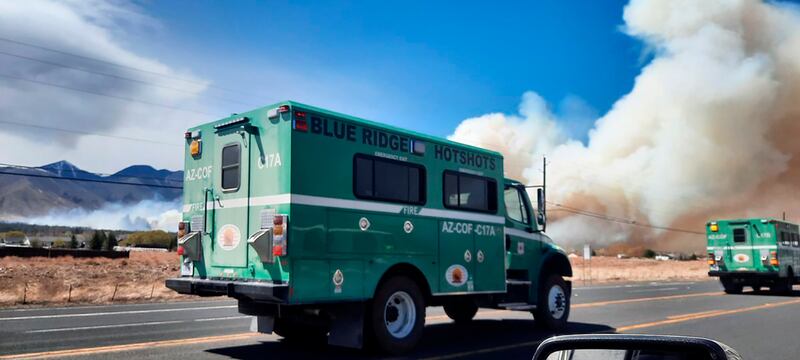A wildfire that has ripped through a drought-stricken area of northern Arizona is sending wildfire smoke into Utah, causing fine particulate pollution levels to spike in the southern region of the state.
The National Weather Service in Salt Lake City is reporting that the smoke from the Tunnel Fire is impacting the Lake Powell area.
That fire has burned more than 16,000 acres, destroyed more than two dozen structures and forced thousands to flee from their homes.
In the dozen counties of Utah where air quality monitors are in place, the Utah Division of Air Quality is reporting elevated values of fine particulate pollution, or PM2.5 — with wind-whipped dust in some areas prompting the agency to warn vulnerable populations to stay inside.
The National Weather Service said a large chunk of Utah will experience strong, gusty winds Thursday in advance of a spring storm moving in Friday that is predicted to bring valley rain and mountain snow.
Wind advisories are in effect in particular for the Salt Lake, Tooele and Sevier valleys, the Swell, western Canyonlands and southwest Utah.
The historic megadrought in the West has turned the wildfire season into practically a yearlong phenomenon.
Last December, the most destructive fire in Colorado’s history started as a grass fire stoked by dangerously high winds.
The rare winter wildfire forced the evacuation of 19,000 people, burned hundreds of homes and led to fatalities.
Jason Curry, deputy director of the Utah Department of Natural Resources, pointed to the Marshall Fire as an example of how drought-parched grass and other vegetation are extending the wildfire season.

The National Interagency Fire Center is reporting 12 large uncontained wildfires that have burned more than 62,000 acres in five states: Arizona, Alaska, Louisiana, Texas and in New Mexico.
A wildfire in Ruidoso, New Mexico, killed an elderly couple in their home earlier this month and destroyed hundreds of homes.
The McBride Fire, like the Tunnel Fire in Arizona, was fanned by high winds.
The fire center is warning of elevated fire potential as this storm moves into the Intermountain West, particularly the southern Great Basin into the southwest and southern Front Range.
Last year, wildfire smoke in the West was so intense it drifted to the East Coast impacting New York.
In Utah, it set pollution levels off the charts, with areas of the state logging the worst pollution in the world.
A study by the National Oceanic and Atmospheric Administration said wildfires in the West are undercutting many of the gains made in the battle against air pollution.
Utah agencies are already urging residents to exercise extra caution in the state due to more than 99% of it being classified as suffering from severe drought.


